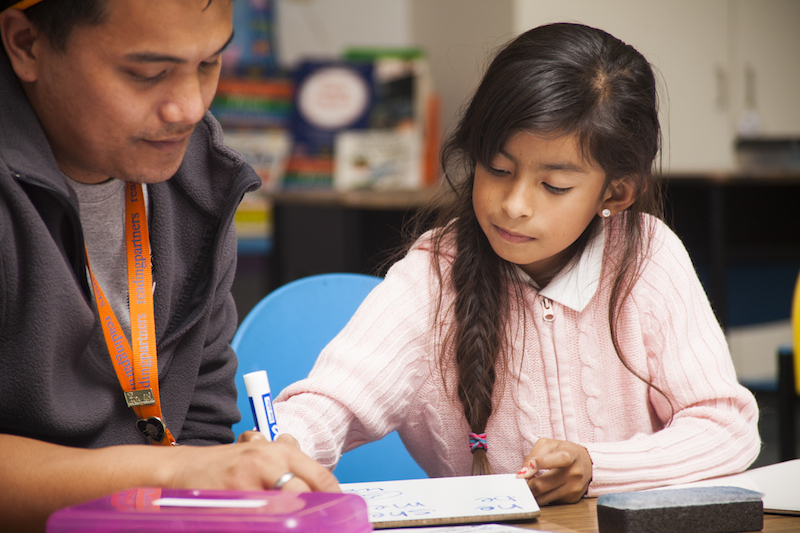May 16, 2015
New research says volunteering really does work. If you do it right.

By Katie Wudel, Good Magazine
The ratio of students to teachers these days is rising at an alarming pace, with UNESCO’s Jordan Naidoo recently claiming that just to meet its universal goals for primary education in 2015, the world would need to enlist an additional 4 million teachers immediately. It might seem like a no-brainer to ask civilians to close that gap. But in the world of education, untrained educators are a rather hot-button topic. “Are they catalysts for change or untrained temporaries?” asks EducationNext. The Atlantic famously claimed last year that amateur educators are no match for the challenges in low-income schools—suggesting that many are there for personal fulfilment, while making things worse for schools and students in the process.
“Volunteers in schools tend to be viewed by professional educators as pencil sharpeners, or people who are good for manning the table at the spring fair. But not for being involved in the actual instructional process,” says Michael Lombardo, CEO of Reading Partners, a national nonprofit organization that mobilizes volunteers in public schools to deliver one-on-one tutoring to struggling readers in low-income communities.
“But schools need to look at volunteers differently, and embrace them as real partners in the education improvement movement,” says Lombardo
According to the census, there are 18 million volunteers in the public schools every year. There are about 3.5 million teachers.
“The human capital is undeniable.”
And that’s not hyperbole. A year-long randomized conrol trial by MDRC, a nonprofit, nonpartisan education and social policy research firm found that community volunteers involved with Reading Partners significantly raise reading proficency at a low cost to schools—for every $1 invested, the Reading Partners volunteer program model delivers over $2 of literacy resources—much more cost-efficient to schools than other supplemental reading programs.
The evaluation took place in 19 schools across three states, involving more than 1,200 second- to fifth-graders, and found a high degree of fidelity—meaning that the more schools use Reading Partners as it is intended to be used, the bigger the boost to students’ reading proficiency. It’s a surpising finding, given the changing nature of the program’s volunteers, who in addition to being diverse in gender and ethnicity range in age from 14 to 80+.
So what is it that makes Reading Partners so effective? Lombardo says, “It’s that we’ve got an interesting juxtaposition of structure and flexibility.” That structure is found in a scaffolded, step-by-step lesson plan for volunteers. There’s also an on-site coordinator who acts as a liaison between volunteers, teachers, and administrators.
Though volunteers and schools are encouraged to adapt the Reading Partners model to make it work for them, Lombardo says there are four non-negotiables:
1. Tutoring has to be one-on-one. “Schools often says small groups work for them, but we really believe in the importance of differentiation and the magic in the relationship between the volunteer and the student.”
2. The Reading Partners curriculum must be used. “It’s unique in that it was developed with volunteers in mind. Most of the reading curricula that schools use is developed for teachers, literacy specialists, or para-professionals. Sometimes schools want us to use their own curriculum, but to make the process smooth and effective for our volunteers, we need to use ours. The data shows that it’s effective, and it’s accessible to non-educators.”
3. Students always get two 45-minute sessions a week. “Sometimes schools say, ‘Why not just once a week?’ But again, we’ve got the data to say pretty compellingly that if we can see the kids for that level of time, we will actually push the needle.
4. Schools need to share their assessment data. “We’re a very data-oriented organization working with really squishy soft skills. The challenge is how to measure it at a minimal cost, which also means we’ve got to know how to target the right students and not waste any time. Our time is for instruction, not testing—that means we need the school’s data so we can monitor our own progress and see how kids are responding.”
Though Lombardo is proud to have evidence about his program’s effectiveness, he knows that the more investment of time and money into programs like Reading Partners, the more literate kids will be. Reading and writing unlocks the door to almost every door in life, he says.
“We’re all busy. If more of us knew that we weren’t wasting our time when we go to a school for an hour—that we were making a meaningful difference in a kid’s life—even if they’re dragging their heels and showing all signs that they don’t want to be there—then more of us would do it. These kids bring a lot of baggage with them into the room, but at the end of the year, the data says that when we give them our time, it works,” says Lombardo.
“And listen, we all have an hour to spare, even if that means skipping an episode ofDancing with the Stars,” he adds.
So if a busy professional knows that she can’t commit much time, but she wants to help, would Lombardo rather have her dollar or an hour of her time? “I can already hear my development staff’s heads exploding as I say this—but I would rather get that hour. She might give us $100 or $1,000 bucks, but the likelihood she’ll give again is low. Once she’s experienced the magic of the program, we know we’ve got her. Our survey data tells us that volunteers leave feeling more willing to give—but also more optimistic about public schools and more willing to vote yes on school bonds. That voter has a network of friends, and they’ll talk about how they worked with a kid in a public school in a challenged neighborhood. That’s a lot better than a check.”











